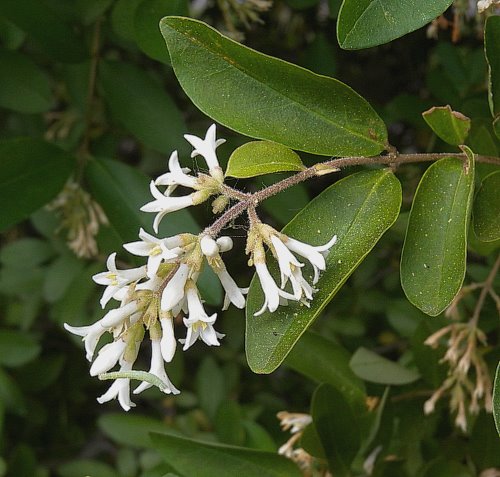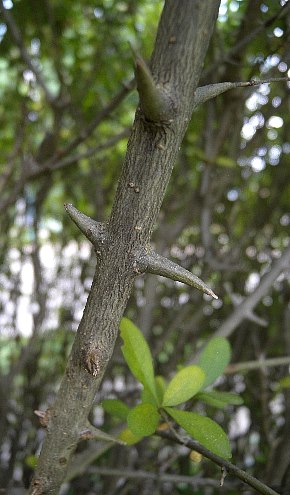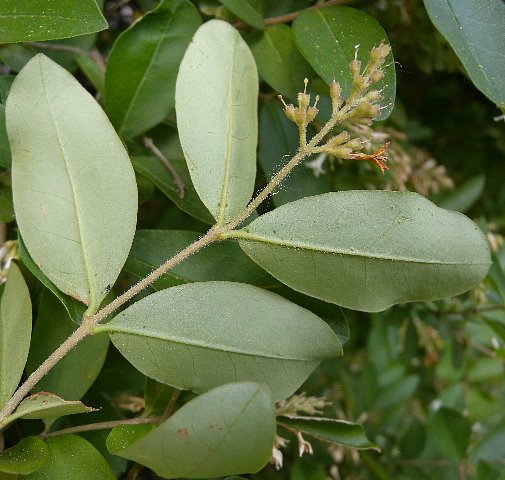
Leafy twigs terminate in panicles of white flowers about 1-2" long; these panicles are pyramidal to ovoid in outline. In addition to the central stalk, each panicle has a few short lateral stalks that terminate in the pedicels of the flowers. These stalks are light green, light brown, or reddish purple; both long and short hairs are present. The pedicels are less than 1/8" (3 mm.) long and usually pubescent. Individual flowers are 1/4-1/3" (6-8 mm.) long, consisting of a trumpet-shaped white corolla and a very short tubular calyx that is pale green to pale yellow. The corolla has 4 spreading lobes that are about one-half the length of the corolla tube, while the calyx has 4 shallow teeth. Each flower also has two stamens with pale yellow anthers and a pistil with a single style; the stamens extend to about the base, or a little beyond the base, of each corolla's lobes. The blooming period occurs during late spring for about 1½ weeks. The flowers have a strong fragrance that is sweet with musty overtones. Afterwards, they wither away and are replaced
 by berries that often
persist until the fall or winter. At maturity, individual berries are
about ¼" long, ovoid-globoid in shape, and bluish black with a dull
white bloom; the interior of these berries is juicy and seedy.
by berries that often
persist until the fall or winter. At maturity, individual berries are
about ¼" long, ovoid-globoid in shape, and bluish black with a dull
white bloom; the interior of these berries is juicy and seedy.Cultivation: The preference is full sun to light shade, moist to dry-mesic conditions, and soil containing loam or clay-loam. Possibly other soil types are acceptable as well. This introduced shrub is easy to cultivate, but it may become invasive in some areas.
Range & Habitat: The non-native Border Privet has naturalized in only a few counties of Illinois (see Distribution Map); it is a rare shrub in the wild. However, these records may underestimate its true distribution within the state, and it may become more common in the future. Border Privet was introduced from Japan or China as an ornamental shrub that can be clipped into a hedge. In naturalized areas, habitats include woodland openings, thickets, roadsides, and vacant lots. Border Privet is often cultivated in yards, parks, cemeteries, and other properties. This shrub has the potential to become invasive within the state.
Faunal Associations: The flowers offer nectar and pollen as rewards to floral visitors. These visitors include honeybees and other bees, the Red Admiral and other butterflies, and probably other insects. The foliage of Privet shrubs (Ligustrum spp.) is eaten by the caterpillars of some Sphinx moths, specifically: Ceratomia undulosa (Waved Sphinx), Sphinx chersis (Great Ash Sphinx), and Sphinx kalmiae (Laurel Sphinx). The caterpillars of Podesesia syringae (Lilac Borer Moth) bores through the woody stems of these shrubs, as do the larvae of the long-horned beetle, Tylonotus bimaculatus (Ash & Privet Borer). Other insect feeders include the aphid, Macrosiphum gei, and the flea beetle, Trichaltica scabricula (Hottes & Frison, 1931; Clark et al., 2004). Among vertebrate animals, the berries are eaten to a limited extent by such songbirds as the Eastern Bluebird, American Tree Sparrow, and Cedar Waxwing (Martin et al., 1951/1961). These birds spread the seeds to new areas. The foliage of Border Privet is more or less toxic to mammalian herbivores and it is usually shunned by them. Both the foliage and berries are toxic to humans.
Photographic Location: Along a sidewalk at the border of a cemetery in Urbana, Illinois.

Comments: Several varieties and subspecies of Border Privet have been described in China and Japan, although the cultivars of this shrub in the United States usually resemble the typical variety or subspecies. Several species of Privet shrubs in Illinois have been introduced from either Europe or Asia, but only Border Privet and Common Privet (Ligustrum vulgare) are known to naturalize within the state. Common Privet is relatively difficult to distinguish from Border Privet, but some useful distinctions can be made: 1) for Border Privet, both the young twigs and stalks of the floral panicles are conspicuously hairy, while for Common Privet they are hairless or minutely pubescent, 2) the floral panicles of Border Privet are 1-2" in length, while those of Common Privet are usually longer, and 3) the corolla lobes of Border Privet are about one-half the length of its corolla tubes, while the corolla lobes of Common Privet are about the same length as its corolla tubes. However, this last distinction may not be reliable in all cases because of the variations that exist within these two species. Another species that is sometimes cultivated, Chinese Privet (Ligustrum sinense), has escaped in other areas of the United States, although apparently not in Illinois. Chinese Privet can be distinguished from the preceding two species by the strongly exerted stamens of its flowers; its anthers extend beyond the tips of the corolla lobes. The anthers of Border Privet and Common Privet, in contrast, extend only to the base, or a little beyond the base, of their corolla lobes.